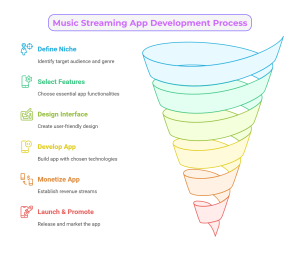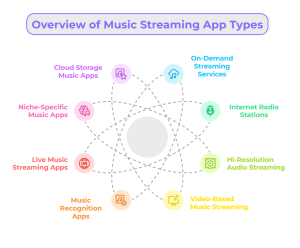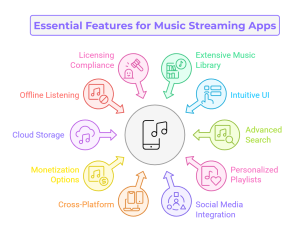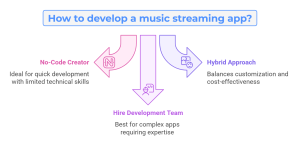Are you passionate about music and are interested in making a music app? With the development of digital streaming, the consumption of music has changed dramatically. Away CD and MP3 are old days of players; Today, people have access to millions of tracks on their fingers, thanks to music streaming platforms.
The demand for music streaming of apps is at a high level, where platforms such as Spotify and YouTube music lead the industry. However, there is still a place for innovation, especially when it comes to increasing user experience, offers unique features and addresses general complaints such as infiltration ads and offline hearing restrictions.
If you are wondering how to create a music app that stands out, this guide will run through the stages required to create a music streaming app, detect main features and discuss different development options, including the best equipment for the cost idea and job
Ready to Build Your Own Music App?
If you’re passionate about music and want to create a cutting-edge streaming app, our experts can guide you through the development process, key features, and cost considerations.
Hire ExpertWhat is a Music Streaming App?
A musical streaming app lets users listen, download and find the music without locally stored on their equipment. These platforms benefit from cloud storage music technology to provide quick access to huge music libraries, and offer features such as individual playlists, high quality sound streaming and social sharing.
The Global Music Streaming Industry is now the right time to create a music streaming app by 2032, with the expectation that CAGR is grow 14.4%.
The interpretation of Globe News Wire is estimated to generate $ 125.7 billion in turnover by 2032 of the music streaming industry.

It shows an attractive opportunity for entrepreneurs and companies who want to invest in app development. If you are planning to launch a music streaming app, this guide will help you through each step.
Step 1: Define Your Niche
To create a successful music app, you need to identify your niche. The industry is very competitive, with apps such as Spotify exclusion in streaming, while Shazam focuses on music recognition.
Ask yourself:
- Who is your targeted audience, random listeners, audio files or indie music lovers?
- Will your app focus on a particular style or field?
By limiting your niche, you can tailor your features and marketing efforts to attract the right users.
Step 2: Select the Right Features
The functionality of your music app plays a crucial role in its success. To create an engaging and user-friendly experience, several key features must be incorporated.
User profiles allow personalization, enabling users to save their preferences, receive tailored recommendations, and create a more immersive listening experience. A robust music search and discovery system ensures quick and accurate results, making it easy for users to find their favorite songs, albums, and artists. Playlist creation and favorites let users curate their own music collections, organizing tracks based on mood, activity, or personal preference.
Seamless streaming and offline playback options are essential, allowing users to enjoy their music uninterrupted, even without an internet connection. Social sharing features enable users to share playlists and favorite songs with friends, increasing engagement and app visibility.
Additionally, advanced features such as AI-powered recommendations, live radio streaming, and collaborative playlists can further enhance user engagement, making the app more dynamic and interactive.
Step 3: Design an interactive interface
A well -designed app improves user storage. Use UX/UX tools such as figs, sketches or Adobe XD to create wireframe and prototype. Best practices include:
- A minimalistic and clutter-free design.
- A dark mode option for low-light usability.
- Fast response times and optimized performance.
Step 4: Develop the App
The development phase brings your concept to life. Choose the right technology stack:
Frontend:
- iOS: Swift or Objective-C
- Android: Kotlin or Java
- Cross-Platform: React Native or Flutter
Backend:
- Node.js or Python (Django/Flask) for API development
- AWS, Firebase, or Google Cloud for data storage
- Additionally, testing tools like Appium ensure smooth functionality across devices.
Step 5: Monetization of your app
A well -defined monetization strategy is important for long -term stability. Popular models include:
- Frimium model: Provide free services for premium features and basic costs for cost.
- Ad: Integrates audio or video ads into the app.
- App shopping: Sell exclusive ingredients, goods or concert tickets.
- Associated marketing: Participated with brands and artists for publicity.
Step 6: Launch and Promote
A strong marketing strategy ensures that your app reaches the right audience. Here are some effective strategies:
- App Store Optimization (ASO): Use relevant keywords and appealing visuals.
- Beta Testing: Gather feedback before the official launch.
- Social Media & Influencers: collaborate with influencers and artists to increase visibility.
Types of Music Streaming Apps

Before diving in the development of music app, it is necessary to understand different types of streaming platforms for music:
1. On-Demand Streaming Services
These platforms let users find and play specific songs, albums or playlists at any time. Examples include Spotify and Apple Music, offering huge music libraries, personal recommendations and offline listening options.
2. Internet Radio Stations
Internet radio stations are similar to traditional radio, these platforms stream curated music and talk content online without user-selected playback. Examples include Pandora, Gridiron Giggles podcast and iHeartRadio.
3. Hi-Resolution Audio Streaming
Hi-Resolution audio streaming are designed for audiophiles, these services focus on premium-quality, lossless audio formats that deliver superior sound fidelity. Examples include Tidal HiFi and Qobuz.
4. Video-Based Music Streaming
These platforms seamlessly combine music streaming with video content, enabling users to watch music videos and live performances effortlessly. For instance YouTube Music and Vevo.
5.Music Recognition Apps
Music recognition apps like Shazam and SoundHound instantly identify songs playing in the background using advanced audio fingerprinting technology.
6. Live Music Streaming Apps
Virtual concerts have become a mainstream method for artists to join fans. Platforms like Twitch and Stageit let viewers enjoy the live performance anywhere in the world. These apps gained tremendous popularity during the epidemic and flowered as hybrid entertainment solutions.
7. Niche-Specific Music Apps
These apps complete specific styles, moods or activities. For example, Cool specializes in calming and relaxation music, while Rock My Run provides curated workout playlists for fitness enthusiasts.
8. Cloud Storage Music Apps
For users who prefer owning their music collection but want the convenience of streaming, cloud storage music apps like Google Play Music (now part of YouTube Music) and Audiomack offer a hybrid solution.
Must-Have Features to Build a Music Streaming App

To create a custom music app that attracts and retains users, you must include the following essential features:
1. Extensive Music Library
Your platform should offer a diverse collection of songs, albums, and artists across multiple genres to appeal to a wide audience.
2. Intuitive User Interface (UI)
A simple and user-friendly interface ensures seamless navigation, allowing users to easily find and play music.
3. Advanced Search Functionality
Implement a robust search system that allows users to find tracks using keywords like artist name, album title, song name, or playlist.
4. Personalized Playlists & Recommendations
Integrating AI-driven algorithms to generate custom playlists and song suggestions based on listening habits enhances user engagement.
5. Social media integration
Allow users to share their favorite songs, playlists and music experiences with friends on social platforms such as Instagram, Facebook and Twitter.
6. Cross Platform Compatibility
Your app should work originally in Android, iOS and browsers to ensure maximum access.
7. Subscription & Monetization Options
Offer multiple pricing models, including:
- Ad-supported free streaming
- Premium subscriptions for ad-free experiences
- Family or student discount plans
8. Cloud Storage Music Integration
Utilizing cloud-based storage allows for fast, scalable, and secure music access, reducing device storage limitations for users.
9. Offline Listening Mode
Enable users to download songs for offline playback, a crucial feature for those who travel or have limited internet access.
10. Music Licensing & Copyright Compliance
Ensure your platform follows music licensing agreements to avoid legal issues when streaming copyrighted content.
How to Make a Music Streaming App: Development Options

When deciding how to build a music streaming app, you have several development paths to choose from:
1. Use a No-Code Music App Creator
No code platforms allow you to draw and let components create an app without coding skills. However, these platforms may lack flexibility to effectively add custom functions or scale as the user base increases.
2. Hybrid Approach:
Professional development combines the efficiency of without code platforms with team adaptation and scalability. Their AI-operated system, Natasha, collects 650+ pre-produced app facilities quickly to reduce the coding time and costs, making it easier to create a music streaming app without breaking the bank.
3. Hire a Mobile App Development Team
Working with professional music app developers ensures high quality development, but the cost of developing the app can be expensive. Developers usually charge an hour or fixed project prices per hour, which can add when they are involved in design, testing and maintenance.
Need Expert Music App Developers?
Work with professional developers to ensure high-quality music app development. Get insights on pricing models, design, testing, and maintenance costs.
Hire ExpertHow Much Does It Cost to Develop a Music App?
The cost of building a music streaming app varies based on complexity and features.
Factors that impact the cost include:
- App Design & UI/UX
- Backend Infrastructure (Cloud Storage Music, APIs)
- Licensing & Royalty Agreements
- Security & Compliance Standards
- Ongoing Maintenance & Updates
Final Thoughts
The world of music app development is huge, and there are many opportunities to create unique, special apps to meet the user’s needs. If you want to create a music streaming app, you will create a music recognition platform, or develop a niche music app, user experience, innovative features and focus on seamless functionality would be important for success.
The construction of a music streaming app is an exciting but challenging effort. You can create a successful app that resonates with users, using the right niche, including legal compliance, ensuring legal compliance and strategic migration methods.
Are you thinking about creating a music app that stands out? Start by choosing the right features to identify the audience and provide a memorable hearing experience.
FAQs:















